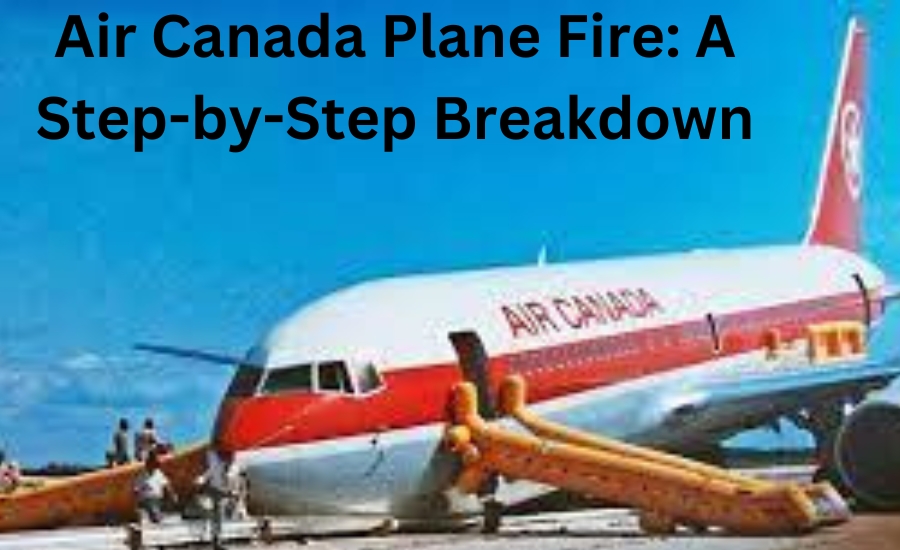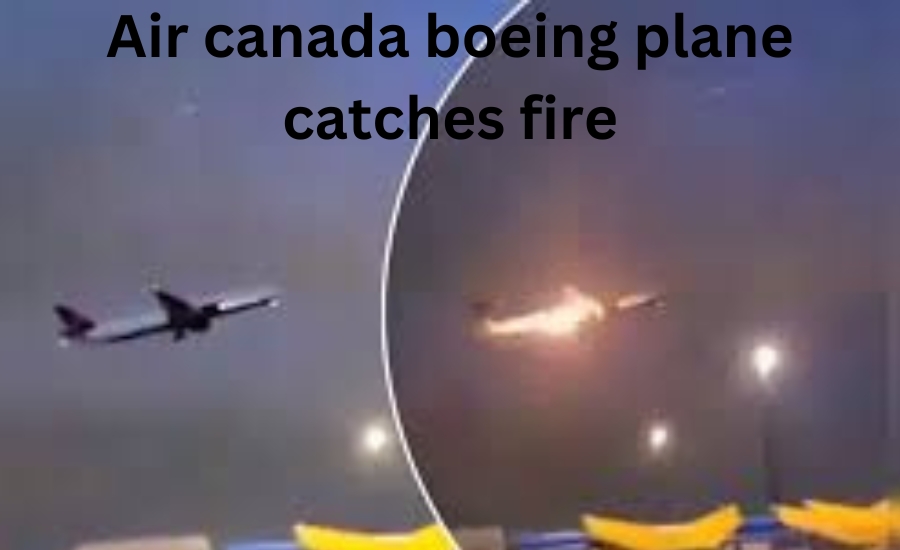Air Canada Boeing plane catches fire in a scary incident that has everyone talking. A video shows the plane’s engine bursting into flames just after takeoff from Toronto. Passengers on the flight were worried, but luckily, the plane landed safely back at the airport.
The Air Canada flight was heading to Paris when the engine trouble started. The airline said the fire was caused by a problem called a “compressor stall.” This is when the engine’s airflow gets messed up, causing flames to show up. Let’s dive into what really happened and how everyone was safe in the end.
What Caused the Air Canada Boeing Plane to Catch Fire?
The Air Canada Boeing plane caught fire due to an engine issue right after taking off. The fire was caused by something called a “compressor stall.” This happens when the engine’s airflow is interrupted, causing flames to appear. It might sound scary, but the plane landed safely and no one was hurt.
When a plane’s engine has a compressor stall, the air moving through the engine gets messed up. This can cause fuel inside the engine to ignite. Although the fire looks dangerous, it is often contained and doesn’t always mean there is major damage to the plane.
The crew and pilots are trained to handle such emergencies. They know what to do to keep everyone safe and make sure the plane lands safely. Air Canada also has strong safety measures to deal with engine issues.
Understanding how these things work can make you feel more comfortable about flying. Even though it was a frightening situation, the airline and its team managed it well.
Air Canada Boeing Plane Catches Fire: The Full Story
The story of the Air Canada Boeing plane catching fire began right after the plane took off from Toronto. As it was climbing into the sky, passengers and airport staff noticed flames coming from the engine. The fire was captured on video and quickly spread on social media.
The plane was on its way to Paris but had to turn around and return to Toronto. Emergency teams were ready when the plane landed. They quickly checked the aircraft to make sure everything was okay and that no one was hurt.
Despite the dramatic video footage, the fire did not cause major harm. The plane was taken out of service for further checks, but the passengers were moved to another flight and continued their journey to Paris.
This incident highlights the importance of safety checks and quick responses in aviation. It’s a reminder that even in emergencies, there are systems in place to handle the situation effectively.
How the Air Canada Boeing Plane Fire Was Handled
When the Air Canada Boeing plane caught fire, the crew acted quickly to handle the situation. As soon as they saw the engine issue, they followed their training to manage the emergency. The plane was safely brought back to the airport where fire crews were ready.
The first responders at the airport did a great job checking the aircraft. They made sure the fire was under control and that the plane was safe. Passengers were then moved to another plane, and the flight to Paris continued after a few hours.
The airline also reviewed what happened to improve their safety procedures. Handling such emergencies well is crucial in aviation. The quick and effective response helped ensure that everyone remained safe and calm.
It’s important to know that pilots and crew are well-trained to manage such situations. Their quick actions and preparation play a big role in keeping flights safe.
The Engine Issue Behind the Air Canada Plane Fire
The engine issue that caused the Air Canada Boeing plane to catch fire was a “compressor stall.” This problem happens when the engine’s airflow is disrupted. It can cause fuel to ignite inside the engine, which leads to flames.
A compressor stall can be caused by various factors, such as changes in the air pressure or engine malfunction. While the flames look dramatic, they often don’t mean that the engine is completely destroyed.
The plane’s crew is trained to handle such engine issues. They follow specific procedures to manage the fire and ensure the safety of everyone on board.
Understanding these technical problems helps reassure passengers. The airline’s focus on safety ensures that even in tricky situations, the response is quick and effective.
Air Canada Plane Fire: A Step-by-Step Breakdown

When the Air Canada plane caught fire, there was a clear process to handle the situation. First, the pilots noticed the problem and decided to return to the airport. The plane landed safely with the help of trained emergency crews.
After landing, the aircraft was immediately checked by fire response teams. They made sure the fire was out and that the plane was in good condition. Passengers were then transferred to another flight, and the original plane was taken out for more inspection.
This step-by-step approach is essential in handling aviation emergencies. It shows how thorough safety procedures and quick thinking are crucial for passenger safety.
Knowing this process can help passengers feel more secure when flying. The airline and its staff are well-prepared to handle unexpected situations effectively.
Not To Be Missed: Danielle-Kaminsky-Teacher
What is a Compressor Stall in an Airplane Engine?
A compressor stall is a problem in an airplane engine that can cause flames. It happens when the airflow inside the engine is disturbed. This can lead to fuel igniting and creating visible flames.
This issue is not very common, but it can happen in various situations. It might be caused by sudden changes in air pressure or other technical factors. While it looks alarming, the engine itself isn’t necessarily damaged beyond repair.
Understanding compressor stalls helps explain why fire in an engine can happen. It’s part of how engines work and why pilots are trained to manage such issues.
Even though it can be frightening, knowing what causes a compressor stall helps make sense of the situation and reassures passengers about flight safety.
Passenger Reactions to the Air Canada Boeing Fire
Passengers on the Air Canada Boeing flight had mixed reactions when they saw the engine fire. Some were understandably scared, while others were relieved to see the plane land safely. Many passengers took to social media to share their experiences.
The video of the fire quickly went viral, adding to the anxiety. However, the quick actions of the crew and the airline’s response helped calm many passengers. The plane’s safe return and the smooth transfer to another flight reassured those on board.
Passengers’ reactions highlight the importance of effective communication during emergencies. Knowing that the airline and crew are prepared helps passengers feel more secure.
Air Canada’s handling of the situation showed their commitment to passenger safety, which is crucial in maintaining trust and confidence in air travel.
How the Firefighters Dealt with the Air Canada Plane Blaze
When the Air Canada plane caught fire, firefighters were ready to act. They met the plane as it landed and quickly worked to put out the flames. Their quick response was vital in ensuring the safety of everyone involved.
Firefighters use special equipment and techniques to handle aircraft fires. They are trained to deal with different types of fires and emergencies, ensuring that the fire is controlled and that the aircraft is safe to inspect.
Once the fire was out, the aircraft was carefully checked for any damage. This thorough process helps prevent further issues and ensures that the plane is safe for future flights.
The teamwork of firefighters and emergency responders is crucial in such situations. Their skills and preparation help manage emergencies effectively and keep everyone safe.
Air Canada Plane Safety Measures After the Fire Incident
After the Air Canada Boeing plane fire, the airline took several safety measures. The plane was inspected thoroughly to check for any damage caused by the fire. This is a standard procedure to ensure the aircraft is safe to fly.
Air Canada also reviewed their safety protocols to learn from the incident. They examined what happened and how the crew handled the situation. This helps improve safety procedures and prevent similar issues in the future.
Passengers were moved to another plane for their journey, ensuring they continued their travel with minimal disruption. The airline’s focus on safety and quick response helped manage the situation effectively.
These measures show how airlines prioritize passenger safety and continuously work to improve their procedures. Understanding these steps can help reassure travelers about flying.
What You Need to Know About Airplane Engine Fires

Airplane engine fires are rare but can happen due to various reasons. A common cause is a problem called a “compressor stall,” which disrupts the engine’s airflow. This can lead to flames, but the situation is usually managed effectively.
Pilots and crew are trained to handle engine fires and other emergencies. They follow specific procedures to ensure the safety of everyone on board. Firefighters and emergency teams are also prepared to deal with such incidents.
Understanding how airplane engine fires are handled can help ease fears about flying. Airlines have strict safety protocols in place to manage emergencies and keep passengers safe.
Knowing these facts can make flying feel less stressful. Safety measures and quick responses are key to handling such situations effectively.
Air Canada Boeing Plane Catches Fire: Eyewitness Accounts
Eyewitnesses to the Air Canada Boeing plane fire had a dramatic view of the incident. Many people saw flames coming from the engine and recorded videos of the event. These videos quickly spread on social media, showing the intensity of the situation.
People who saw the fire were understandably worried. The dramatic footage added to the concern, but it also highlighted how quickly the situation was managed. The plane landed safely, and there were no injuries reported.
Eyewitness accounts provide valuable insights into how the incident unfolded. They show the human side of the emergency and the impact on those who experienced it firsthand.
These accounts also help explain the response and handling of the situation. They reassure passengers that safety measures are in place to deal with such emergencies effectively.
How Common Are Engine Fires in Planes?
Engine fires in planes are not very common but can occur. They are usually caused by issues like compressor stalls, which disrupt the engine’s airflow. While they may seem alarming, pilots and crew are trained to handle such situations.
Modern aircraft are designed with safety in mind, including features to manage engine fires. Emergency procedures and quick responses help ensure that the fire does not lead to major damage or injuries.
Understanding the rarity of engine fires can help reduce anxiety about flying. Airlines and flight crews are well-prepared to manage these situations and keep passengers safe.
Knowledge of how uncommon and manageable engine fires are can make flying feel less frightening. Safety measures are in place to handle these emergencies effectively.
The Role of Pilots in Handling Air Canada Plane Fires
Pilots play a crucial role in managing emergencies like the Air Canada plane fire. When an engine issue arises, they follow specific procedures to handle the situation safely. Their training helps them stay calm and focused during such incidents.
In the case of the Air Canada fire, the pilots decided to return to the airport as soon as they noticed the problem. They followed emergency protocols to ensure the plane landed safely and the passengers were secure.
The quick and effective actions of the pilots are essential in handling emergencies. Their training and experience help manage situations like engine fires and ensure passenger safety.
Knowing the role of pilots in such scenarios can reassure travelers. Their skills and procedures are key to handling emergencies and keeping flights safe.
Understanding the Engine Trouble in the Air Canada Fire Incident
The engine trouble that caused the Air Canada Boeing plane fire was a compressor stall. This problem disrupts the engine’s airflow, leading to flames. It’s a technical issue but is managed effectively by the plane’s crew.
During a compressor stall, the airflow in the engine gets messed up, causing fuel to ignite. While the flames look dangerous, they often don’t mean that the engine is seriously damaged.
Understanding these technical problems can help explain why they happen and how they are managed. It’s part of how engines work and why pilots are trained to deal with such issues.
Knowledge of engine troubles like compressor stalls helps make sense of the situation and reassures passengers about flight safety.
Why the Air Canada Boeing Plane Fire Was Not as Dangerous as It Looked

The Air Canada Boeing plane fire looked frightening, but it was not as dangerous as it seemed. The flames were caused by a compressor stall, a problem that disrupts airflow in the engine. This issue is usually contained and managed effectively.
The plane’s crew and emergency responders acted quickly to handle the situation. They followed safety procedures to ensure the fire was controlled and that the plane landed safely.
The aircraft was thoroughly inspected after landing to make sure it was safe. The quick response and careful handling helped prevent any major harm.
Understanding why the fire was not as dangerous as it looked can help ease concerns about flying. The safety measures and procedures in place ensure that such situations are managed effectively.
How Air Canada Ensures Passenger Safety After a Fire
After the Air Canada Boeing plane fire, the airline took several steps to ensure passenger safety. The plane was inspected for any damage, and a thorough check was done to make sure it was safe for future flights.
Air Canada also reviewed their safety procedures to learn from the incident. This helps improve protocols and prevent similar issues in the future. Passengers were accommodated on another flight, ensuring their journey continued with minimal disruption.
The airline’s focus on safety and quick response demonstrates their commitment to passenger well-being. These actions help maintain trust and confidence in air travel.
Knowing how airlines ensure safety after such incidents can provide reassurance to travelers. The commitment to safety is key to handling emergencies effectively.
Lessons Learned from the Air Canada Boeing Plane Fire
The Air Canada Boeing plane fire taught valuable lessons about handling aviation emergencies. The incident highlighted the importance of quick and effective responses by the crew and emergency responders.
The airline reviewed the situation to learn from it and improve safety procedures. This helps prevent similar issues and ensures that safety measures are updated as needed.
Understanding the lessons from the fire incident helps improve aviation safety and reassures passengers. It shows how airlines continuously work to enhance their procedures and handle emergencies better.
These lessons contribute to safer flying experiences and demonstrate the ongoing efforts to improve air travel safety.
What to Do If You See Flames on a Plane: Air Canada’s Fire Incident Explained
If you see flames on a plane, it’s important to stay calm and follow the crew’s instructions. The Air Canada plane fire incident shows how quickly such situations are managed. The plane landed safely, and the crew handled the emergency effectively.
Passengers are trained to listen to the crew and follow safety procedures in emergencies. The crew’s training helps them manage such situations and ensure everyone’s safety.
Knowing what to do if you see flames can help you stay calm and focused. The response from the crew and emergency responders is designed to keep passengers safe and manage the situation effectively.
Conclusion
In conclusion, the recent incident with the Air Canada Boeing plane catching fire might have seemed scary, but it was handled very well. The flames from the engine were caused by a problem called a compressor stall, but thanks to the quick actions of the pilots and emergency responders, everyone on board was safe. The plane landed back at the airport without any injuries, and the passengers were soon on their way to Paris on another flight.
Air Canada and their team showed great skills in managing the situation. They made sure the plane was checked thoroughly and took steps to prevent similar issues in the future. Knowing that such incidents are managed carefully can make flying feel less worrying. The safety and well-being of passengers are always the top priorities for airlines.
Get More Information: Melanie-lynn-cates
FAQS
Q: What caused the Air Canada Boeing plane to catch fire?
A: The fire was caused by a problem called a compressor stall, which disrupts the airflow in the engine and can cause flames.
Q: How did the Air Canada plane handle the engine fire?
A: The plane landed safely back at the airport, and the crew followed procedures to manage the fire. Emergency responders quickly took care of the situation.
Q: Were there any injuries from the Air Canada plane fire?
A: No, there were no injuries reported. All passengers and crew were safe during the incident.
Q: What happens to the plane after such a fire incident?
A: The plane is inspected thoroughly to check for any damage. It is then taken out of service for further evaluation and repairs.
Q: How common are engine fires on airplanes?
A: Engine fires are rare. They can happen due to various issues, but airlines and crews are well-trained to handle them safely.
Q: What is a compressor stall?
A: A compressor stall is when the airflow through the engine is disrupted, which can cause fuel to ignite and create flames.
Q: How are passengers accommodated if their flight is affected by an incident?
A: Passengers are usually moved to another flight or provided with alternative arrangements to continue their journey with minimal delay.
Q: What steps do airlines take to prevent similar incidents?
A: Airlines review the incident, improve safety procedures, and ensure that maintenance and inspections are thorough to prevent similar issues in the future.
Q: How should passengers respond if they see flames on a plane?
A: Passengers should stay calm and follow the crew’s instructions. The crew is trained to handle such emergencies and keep everyone safe.





